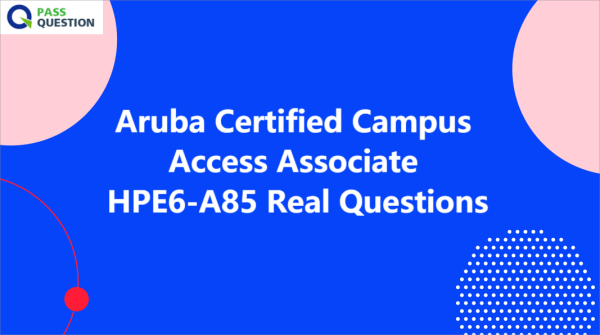
Aruba Certified Campus Access Associate Exam
The Aruba Certified Campus Access Associate Exam is an essential certification for any networking professional. Passing the HPE6-A85 exam opens up new opportunities for career advancement and growth in the field of networking. PassQuestion provides Aruba Certified Campus Access Associate HPE6-A85 Real Questions that can help candidates pass the Aruba Certified Campus Access Associate Exam easily. The Aruba Certified Campus Access Associate HPE6-A85 Real Questions are designed to simulate the actual exam environment, allowing candidates to get a feel for the type of questions they will face. The questions are updated regularly to ensure that they are relevant and up-to-date with the latest exam objectives.

This exam validates the candidate's basic wired and wireless network knowledge, including routing/switching, basic RF concepts, basic security, connectivity, monitoring, and reporting. The typical candidate for this certification is a network field technician, deployment technician, NOC Level 1, or junior network engineer with hands-on experience with Aruba products. The ideal candidate has 1+ years of experience with networking and a vendor agnostic understanding of basic network protocols. Under the direction of a Professional or Expert, the candidate can apply the configuration and verify the status of a campus network.
Exam Details
Exam ID: HPE6-A85
Exam type: Proctored
Exam duration: 1 hour 30 minutes
Exam length: 60 questions
Passing score: 67%
Delivery languages: Latin American Spanish, English, Japanese
Exam Objectives
7% Network Stack
1.1 Describe and differentiate various OSI Model layers and architectural elements
1.2 Describe and differentiate TCP/IP stack
10% Connectivity
2.1 Identify foundational networking architectures and technologies.
2.2 Describe network infrastructure deployment
8% Network Resiliency and virtualization
3.1 Describe mechanisms for resiliency, redundancy, and fault tolerance
3.2 Manage an infrastructure device (AP, gateway, switch)
19% Switching
4.1 Describe the basics of Layer 2/3 technologies
4.2 Review and apply a campus architecture and elements based on a given template
18% WLAN
5.1 Describe fundamental RF attributes and wireless functions
5.2 Create a AP GUI configuration group
9% Routing
6.1 Differentiate between basic routing topologies and functions
6.2 Evaluate and deploy basic routing topologies
9% Security
7.1 Define fundamental security standards and concepts
7.2 Integrate wireless SSID into an existing ClearPass deployment
6% Authentication/Authorization
8.1 Describe and differentiate between AAA concepts
7% Management and Monitoring
9.1 Define and differentiate between common tools used for network monitoring
9.2 Evaluate and interpret UXI test results
9.3 Use Central to monitor network health
4% Troubleshooting
10.1 Define Basic Troubleshooting methodologies
3% Performance Optimization
11.1 Describe QoS
View Online Aruba Certified Campus Access Associate Exam HPE6-A85 Free Questions
1. You need to troubleshoot an Aruba CX 6200 4-node VSF stack switch that fails to boot correctly Select the option that allows you to access the switch and see the boot options available for OS images and ServiceOS.
A.Member 2 RJ-45 console port
B.Member 2 switch mgmt port
C.Conductor USB-C console port
D.Conductor mgmt port using SSH
Answer: C
2. Which Aruba technology will allow for device-specific passphrases to securely add headless devices to the WLAN?
A.Wired Equivalent Privacy (WEP)
B.Multiple Pre-Shared Key (MPSK)
C.Opportunistic Wireless Encryption (OWE)
D.Temporal Key Integrity Protocol (TKIP)
Answer: B
3. What does WPA3-Personal use as the source to generate a different Pairwise Master Key (PMK) each time a station connects to the wireless network?
A.Session-specific information (MACs and nonces)
B.Opportunistic Wireless Encryption (OWE)
C.Simultaneous Authentication of Equals (SAE)
D.Key Encryption Key (KEK)
Answer: A
4. What happens when the signal from an AP weakens by being absorbed as it moves through an object?
A.APs will use bonded channels to decrease latency to clients
B.Signal to Noise Ratio (SNR) increases
C.Signal to Noise Ratio (SNR) decreases
D.Aruba Central dynamically moves clients to neighboring APs
Answer: C
5. A network technician is using Aruba Central to troubleshoot network issues Which dashboard can be used to view and acknowledge issues when beginning the troubleshooting process?
A.the Alerts and Events dashboard
B.the Audit Trail dashboard
C.the Reports dashboard
D.the Tools dashboard
Answer: A
6. What is an advantage of using Layer 2 MAC authentication?
A.it matches user names to MAC address
B.No setup is required on the client
C.MAC allow lists are easily maintained over time
D.MAC identifiers are hard to spoof
Answer: B
7. Which device configuration group types can a user define in Aruba Central during group creation? (Select two.)
A.Security group
B.Template group
C.Default group
D.Ul group
E.ESP group
Answer: B, C
8. Which Protocol Data Unit (PDU) represents the data link layer PDU?
A.PDU1 - Signal
B.PDU2 - Frame
C.PDU3 - Packet
D.PDU4 - Segment
Answer: B
Related Courses and Certification
Also Online IT Certification Courses & Online Technical Certificate Programs

